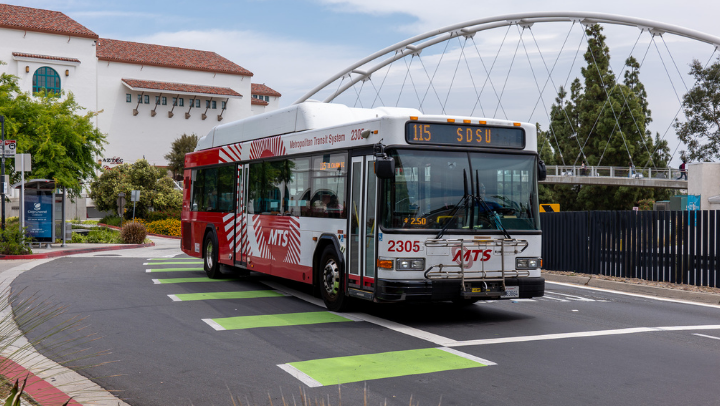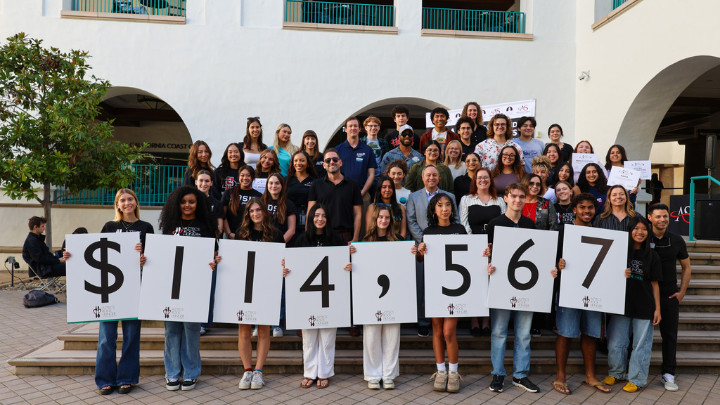The road not taken: SDSU’s 10-year trek toward transportation improvements and evaluation
SDSU commuters increasingly turn to transit, biking, and carpooling, signaling a campus-wide move toward more sustainable travel habits.

San Diego State University’s commuter community appears to be heeding the call for a more sustainable future, shifting―at least slightly―away from solo drives to campus and into the use of increasingly abundant transit and environmentally friendly options.
The trends were captured by SDSU’s 10th annual Transportation Survey, which drew a record breaking 3,440 responses. The data signals a decline in drive-alone commuting and increased transit use across the campus community.
Led by Bruce Appleyard, professor of City Planning and Urban Design, the survey is a partnership between the School of Public Affairs, the Office of Energy and Sustainability, and Parking and Transportation Services.
Among the commuters traveling to and from campus, changes seen between spring 2024 and spring 2025 include:
- On-campus students (within ¼ miles): Transit usage rose by 4%, while the drive-alone rate dropped by 2%. Only 11% commute alone by car.
- Off-campus students (more than ¼ mile away): Transit usage grew by 2% and the drive-alone rate declined by 3%.
- Faculty and staff: Transit usage increased by 4% and solo driving decreased by 4%.
The survey included 874 students living on campus or within a quarter-mile of it and found a shift in how students commute: public transit use rose by 4 percentage points, while the share of those driving alone fell by 2 points between the spring semesters of 2024 and 2025. If the trend holds across the broader population of roughly 8,500 students in the same area, it suggests that about 340 more students are now riding transit, while approximately 170 fewer are commuting alone by car.
Similar trends are observable among SDSU’s approximately 6,900 faculty and staff, suggesting that around 276 more university employees have chosen transit over driving alone.
The impact on commuting starts with students.
"Through improved transit access and efficiency, students are able to rely less on driving alone, saving time and money associated with commuting costs while avoiding the stress involved in dealing with daily traffic or finding parking on campus," said Madison Cranford, a graduate student researcher. "The benefits of this extends past the students, helping to promote cleaner air, quieter neighborhoods, and less traffic congestion throughout the San Diego Community.” Moreover, increased use of public transit generates support and resources for the broader transit network, promoting sustainable growth and mobility options citywide.
SDSU has made a priority of actively easing traffic congestion and promoting sustainable travel through its Transportation Demand Management (TDM) strategies. By aligning climate action planning and TDM incentives, SDSU has accommodated rising enrollment and employment while shifting more trips to transit, carpooling, car sharing, and other low-impact modes. Programs such as subsidized transit passes, expanded Zipcar car availability, Daily Choice parking, and enhanced bike/scooter resources have contributed to more flexible and sustainable mobility options on and around campus.
More than half of the student respondents in the 2025 survey expressed interest in a future universal transit pass program (“U-PASS”). Nearly eight out of 10 said they would use transit if a pass were included in the cost of attendance.
Located along the Green Line trolley and served by five MTS bus routes, SDSU is poised to lead the region in sustainable commuting. By eliminating the need to commute to campus, students that live on or near SDSU contribute to reduced vehicle miles traveled and fewer Scope 3 emissions. These are indirect greenhouse emissions that occur because of an institution’s activities but come from sources not owned or controlled by the SDSU.
The impacts of these choices reach beyond mere convenience, they also tackle pressing environmental issues. A 2018 peer-reviewed publication led by Appleyard found that each student housed on campus significantly reduces carbon emissions by roughly one ton annually. With new initiatives such as Evolve Student Housing, the university is enhancing on-campus living options, further reducing carbon footprints, easing traffic around campus, and supporting student success.
“As a longstanding member of the College Area, SDSU is committed to being a responsible neighbor and environmental steward,” said JD Weidman, director of Parking and Transportation Services. “We are proud of the transportation improvements we have achieved and will continue working to reduce Scope 3 emissions from transportation and investing in ways that ensure our students, faculty, staff and neighbors can safely live, learn and thrive well into the next century.”



